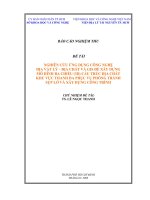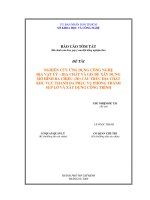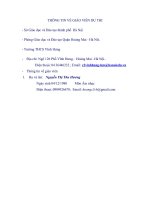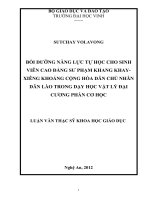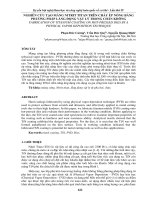VẬT lý địa CHẤN 05 amplitudes
Bạn đang xem bản rút gọn của tài liệu. Xem và tải ngay bản đầy đủ của tài liệu tại đây (189.59 KB, 8 trang )
Processes altering seismic amplitudes
(Reynolds, 1998)
Seismic amplitudes
Affected by
• Reflection and transmission at an interface
• Geometrical spreading
• Absorption
• Receiver response
• Measurement system
Geometrical spreading
Energy proportional to:
r1
Plane wave:
constant
Cylindrical wave:
~ 1/r
Spherical wave:
~ 1/r2
r2
Energy is proportional to (Amplitude)2
⎛ E (r1 ) ⎞
⎟⎟
Attenuation due to geometrical spreading: 10* log⎜⎜
⎝ E (r2 ) ⎠
10
Absorption
Transformation of Energy into Heat
Amplitude:
A = A0e
− αx
α = Absorption coefficient
Energy is proportional with A2
Quality factor
Q=
2π
E
= 2π
=
∆E / E
∆E
2π
Part of energy, that is lost in a cycle
Relation between Q and α
1 αv αλ
=
=
Q πf
π
Absorption is frequency dependent
πf
α=
Qv
Common Earth materials
0.25 < α < 0.75 (dB/λ)
300 > Q > 50
π
Q=
αλ
Note: exp(-αx)
Question 1:
•
•
•
•
•
20 Hz seismic wave
Travels with 5 km/s
Propagates for 1000 m. through
Medium: absorption coefficient 0.25 dB/λ
What is the wave attenuation in dB due
solely to absorption?????
Answer:
λ=v/f= 250 m: absorption: 4*0.25=1 dB
Question 2:
• Wave with λ=100 m propagates through
homogeneous medium
• Between two detectors at radial distances of 1 km
and 2 km the wave amplitude is attenuated by 10
dB.
• Calculate contribution of geometrical spreading to
this value of attenuation and, thus, determine the
absorption coefficient of the medium in dB/ λ.
10 dB in 1000 m: 1 dB/ λ
Geometrical spreading: 20 10log (A0/A)= 20 10log (2)=6dB/ 1km
= 0.6 dB/ λ ⇒ absorption coefficient: 1-0.6=0.4 dB/ λ!



